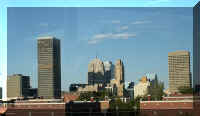
Oklahoma City, OK - Fall 2006
Updated: 11/09/08
National Cowboy and Western Heritage Museum
Oklahoma City National Memorial and Museum
The bronze figure of an American Indian is on top of the Capitol Building.
To rejuvenate the downtown area, the city built a canal in what they call Bricktown. The city owns the Bricktown Canal, the boats are vendor owned. The city fire hydrants are used to fill the canal. The area now draws people to the shops and restaurants. We chartered two boats for our group. It was an interesting and fun ride through the canal. A fee of $6.50 (seniors $5.50) lets you ride all day.
The city is in the process of erecting 46 (they were the 46th state admitted to the Union) Land Run Sculptures in their Centennial Park. Some will be visible from the canal boats.
The city sells buffalos as a fund raiser. Did you notice the short pants on the UPS buffalo?
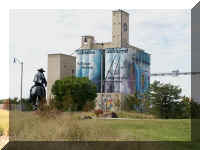
National Cowboy and Western Heritage Museum
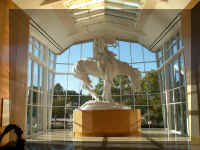
Sculptures were plentiful inside and outside the building.
Many exhibits show the cowboy and western way of life.
This exhibit had a sky at twilight - too dark for good photographs.
A display of 1.300 types of barbed wire fencing was well organized. If you look closely at the photograph on the right, you will noticed some of them are barbed wood fencing.
One room had a large collection of branding irons.
The floor in one room was tiled with a map indicating the large ranches and their livestock brands.
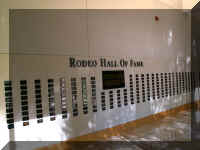
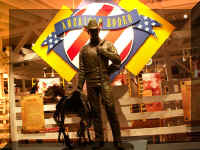
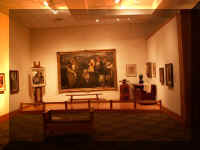
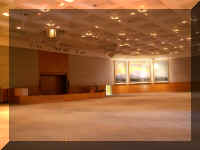
NOTE: Our bus driver gave us two hours for this attraction. If time permits, we suggest you allow at least three hours. Admission is $8.50 for adults, $7.00 for seniors and $4.00 for children (6-12). It is open 9am - 5pm daily.
Oklahoma City National Memorial and Museum
This memorial honors the victims, survivors, rescuers and all who were changed forever on April 19, 1995 when the Alfred P. Murrah Federal Building was bombed.
The Outdoor Symbolic Memorial includes The Gates of Time, Reflecting Pool, Field of Empty Chairs, Children Area, Rescuers' Orchard, The Survivor Tree, Fence and Survivor Wall. The story told by the park ranger regarding the symbolism of each item and its placement was very moving.
The Gates of Time frame the moment of destruction 9:02
and mark the formal entrances to the Memorial.
The gently flowing water of The Reflecting Pool is intended
to
soothe wounds, with gently flowing water and calming sounds.
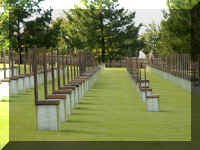
In the Field of Empty Chairs, each chair is made of bronze
and stone, its glass base is etched with the name of a victim.
(When lit at night, the names are more visible.)
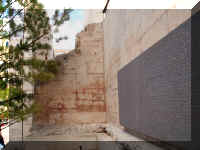
The Survivor Tree, a 90 year old American Elm, stands as symbol of human resilience. The plaque reads: The spirit of this city and this nation will not be defeated; our deeply rooted faith sustains us.
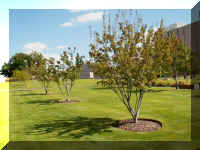
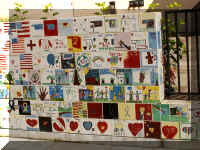
These oversize chalkboards provide a place where children of all ages can continue to share their feelings.
These maps show how the area was changed.
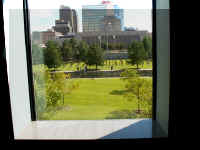
A portion of the fence that surrounded the bombed building was retained as part of the memorial. This fence was moved to its current location by family members, survivors and rescue workers at the time of the ground breaking of the Memorial. There are more than 200 feet of the fence where visitors can leave tokens of remembrance and hope.
The Oklahoma City National Memorial visit was very moving. The Memorial's Missions statement is powerful: "We come here to remember those who were killed, those who survived and those changed forever. May all who leave here know the impact of violence. May this memorial offer comfort, strength, peace, hope and serenity."
The Outdoor Symbolic Memorial is open 24 hours a day, seven days a week. There is no charge to tour the Memorial grounds. The Memorial Museum tickets are $8 for adults, $7 for seniors. It is open Monday - Saturday 9 a.m. - 6 p.m. and Sunday 1 - 6pm.
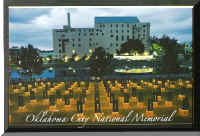 Our
bus tour took place in the mid-afternoon. A friend let me scan a postcard she
purchased so I could see and show you a night view. (Thanks,
Marilyn P.)
Our
bus tour took place in the mid-afternoon. A friend let me scan a postcard she
purchased so I could see and show you a night view. (Thanks,
Marilyn P.)